Round The World and other travels
A frequent flyer's collection of trip diaries
This is: A Yorkshire Ramble (2014)
Whitby: a coastal gem
I had an excellent night's sleep, first opening my eyes after seven solid hours of rest, aware that I had been dreaming vividly but unable to grasp hold of any of the transitory wisps of subject matter that seemed to drift before me, apparently just within reach, before dissipating for ever. I had a quiet breakfast around 7:30. Following two days of miserable weather, it was heartening to see the sun breaking through already and I was full of anticipation for my steam-train crossing of the North York Moors.
North Yorkshire Moors Railway
Although I purposely arrived at the station early, it turned out that there was already plenty of activity, although it was never going to be overly busy at this time of year. The traditional maroon-liveried coaches for the train were already on the platform and the steam engine soon arrived, filled up with water and was coupled to the front of the train in such a way as to face backwards, so that the tender would be going first. I found a seat and was glad that, some minutes after the engine had been fully hooked up, a few fleeting hints of warmth started to drift tentatively upwards from the ancient, floor-level heaters.
The train pulled out exactly on time, with just about every window seat occupied in my chosen coach, the second from the front. The railway was originally part of a through connection from York to Whitby, planned by no less a personage than George Stephenson. Trains used the Scarborough line as far as Malton before branching off to follow a route through Pickering to Grosmont, where the line merged with the Esk Valley route for the last few miles into Whitby. The Malton-Grosmont section was closed as part of the 1965 Beeching cuts, but the Pickering-Grosmont section was reopened by a group of preservationists in 1973 and through runs to Whitby over what are now Network Rail tracks recommenced in 2007. Today, the NYMR is the UK's most popular heritage railway, judging by passenger numbers.
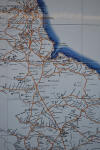 |
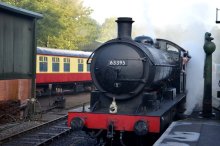 |
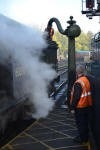 |
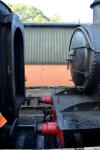 |
 |
 |
 |
 |
| ABOVE and RIGHT: Arrival in Whitby |
 |
 |
 |
 |
ABOVE and LEFT: Crossing the North York Moors by steam train |
As the journey got underway, I bought a copy of the official guidebook as a souvenir. The ticket inspectors and catering staff, all mainly volunteers, were very neatly turned out in traditional-looking uniforms. I also bought a coffee, partly as a means of keeping warm.
There was a lengthy stop at Grosmont for an engine change, but the opportunity was also taken to wash the windows on the side of the train adjacent to the station platform. Another steam train was ready to depart in the opposite direction, and with gorgeous, blue-sky conditions prevailing, some professional-looking camera gear had turned out in force. We left a little late for the final section to Whitby, but nobody seemed to mind. The NYMR and Esk Valley lines merged immediately after Grosmont station and a few minutes later, as we swung into Whitby, I could immediately tell that this was going to be a picturesque destination. I waited at the station long enough to see the engine being uncoupled and moving to the other end of the train in readiness for its next southbound journey.
Whitby's East Side
I made my way to my latest accommodation, dropped my luggage off and made a dinner reservation for the highly regarded in-house restaurant that probably formed the main part of the business. As it was only 11:30, I decided that before thinking about lunch I would cross the River Esk using the Swing Bridge and climb the 119 Steps to St Mary's Church and the ruins of Whitby Abbey - that should get the circulation going! Walking between the bridge and the foot of the steps, I was intrigued by the quaint little pedestrianised streets and by the number of shops featuring jewellery made from Whitby Jet, which was used by the Romans and again became popular in Victorian times. Climbing the steps gave some fabulous views across the town, which provided the perfect excuse for making several pauses during the fairly arduous ascent! Immediately adjacent to the top of the steps was the Church of St Mary, dating from the 12th century, the graveyard of which provided the setting for part of Irish author Bram Stoker's novel, Dracula.
 |
 |
 |
 |
 |
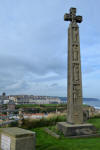 |
 |
 |
 |
 |
 |
|
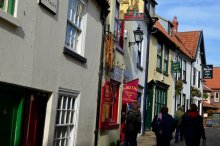 |
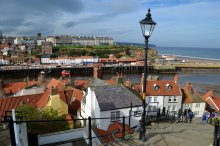 |
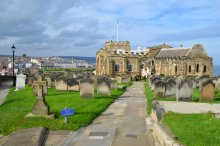 |
|||
Whitby Abbey
The steep part of the ascent now over, I continued up the gentle slope to the plateau of Whitby's East Cliff, home to the spectacular ruins of a large Benedictine abbey. The first monastery was built here in the 7th century, but the current structure dates from the 13th century. Following the dissolution of the monasteries in 1538, the main church has progressively deteriorated over the centuries, while the other original monastic buildings have disappeared altogether. The ruins, now standing in splendid isolation, are in the care of English Heritage.
 |
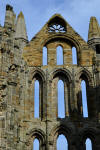 |
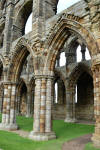 |
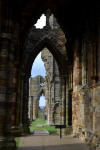 |
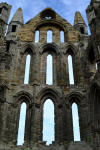 |
 |
 |
 |
Captain Cook
It was time to return to sea level and I walked back down the steps under ominous signs of an impending shower. There were two further items of business to attend to on the eastern bank of the Esk and the first of these was lunch. I had an enjoyable light meal of quiche and salad, followed by a cappuccino and a slice of carrot cake, in a traditional café.
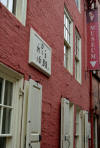 Interestingly,
the patrons included a same-sex couple with a well-behaved and
clearly intelligent toddler. What intrigued and delighted me were
the reactions of other customers, many of whom smiled across or made
small-talk over things the little boy said. I noticed some
whispering taking place at the table nearest me, followed by a
wide-eyed look from an elderly member of the group of three, and
wondered whether the atmosphere might be about to change. I couldn't
have been more wrong: before leaving, the old woman made a point of
going over to the table to make a fuss of the child and have a
friendly chat with the two daddies. Here in rural Yorkshire, it was
a heartwarming demonstration of positive social change during the
course of my own lifetime.
Interestingly,
the patrons included a same-sex couple with a well-behaved and
clearly intelligent toddler. What intrigued and delighted me were
the reactions of other customers, many of whom smiled across or made
small-talk over things the little boy said. I noticed some
whispering taking place at the table nearest me, followed by a
wide-eyed look from an elderly member of the group of three, and
wondered whether the atmosphere might be about to change. I couldn't
have been more wrong: before leaving, the old woman made a point of
going over to the table to make a fuss of the child and have a
friendly chat with the two daddies. Here in rural Yorkshire, it was
a heartwarming demonstration of positive social change during the
course of my own lifetime.
The second item of business was a visit to the Captain Cook Memorial Museum, which occupies the former home of Captain John Walker, to whom the young James Cook was apprenticed in 1746. The museum contained many Cook-related artefacts and depictions of 18th-century life in this port town.
The Town
I had managed to miss the predicted shower while I was in the museum, and when I eventually crossed back to the west bank and the main part of town, there were already tentative signs of a possible return to bright skies. I spent some time in the harbour area, eschewing attractions such as The Dracula Experience, an RNLI lifeboat museum and a weird steam bus that was offering tours alongside more conventional vehicles. I did, however, walk out to the end of the breakwater separating the river mouth from the beach.
| RIGHT: Some views of Whitby Harbour |
 |
 |
 |
 |
 |
 |
 |
 |
| ABOVE: Whitby's very own Khyber Pass | ||
With the town's East Cliff already conquered, it was now time to ascend the West Cliff via a winding road bearing the remarkable name Khyber Pass. The road led up to the East Terrace and North Terrace, home of the Royal Hotel, and a viewpoint marked by a whalebone arch and a statue of Captain Cook. During the last part of the climb, I had passed a park bench bearing a floral decoration relating to Dracula.
 |
 |
 |
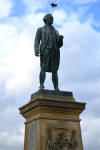 |
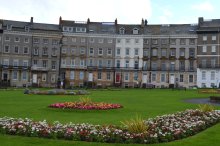 |
 |
 |
 |
 |
 |
| ABOVE: Pannett Art Gallery and gardens | |
Just off North Terrace was the imposing Royal Crescent; I took the central exit from this, Crescent Avenue, to reach my final objective of the day, Pannett Art Gallery and park. The art gallery shared a building with Whitby Museum. I felt I only had time for one of these and chose the gallery.
Hotel of the Trip
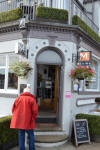
 I
made my way back to my new base around 4pm and was given access to
my truly fabulous duplex suite, complete with stunning views over
the Esk. I had a cup of tea, relaxed for a while, watched some TV
and generally luxuriated in my surroundings.
I
made my way back to my new base around 4pm and was given access to
my truly fabulous duplex suite, complete with stunning views over
the Esk. I had a cup of tea, relaxed for a while, watched some TV
and generally luxuriated in my surroundings.
As my chosen mealtime approached, I decided to treat myself to a cocktail in the bar and ordered a Kir Royale, transferring to the dining room around 7pm while a spectacular thunderstorm raged outside. I enjoyed an astonishingly good dinner of Gravadlax, followed by the special of the day, haddock on a New England chowder. It felt as though I was in training for my next big trip, due to be underway before the month was out.
I rounded off a wonderful dinner with an Irish Coffee. Returning to my room, I watched The World is Not Enough on satellite TV, but I have to confess to missing a substantial middle chunk of the film due to falling asleep on the sofa.